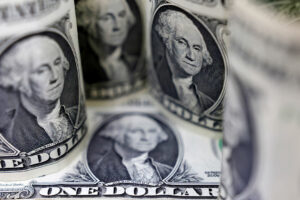




Philippines Trade Update: Trade trajectories trend along
 DOWNLOAD
DOWNLOAD

Policy Rate Updates: Double cut finale
 DOWNLOAD
DOWNLOAD

Monthly Economic Update: One for the road
 DOWNLOAD
DOWNLOAD


Philippine May dollar reserves slide

Philippine dollar reserves slipped at the end of May as the government paid its debt and the value of the central bank’s gold holdings declined.
Data released by the Bangko Sentral ng Pilipinas (BSP) on Wednesday showed the gross international reserves (GIR) slid by 0.5% to USD 101.3 billion (PHP 5.675 trillion) from April. Year on year, the reserves declined by 2.3%.
This was the lowest dollar reserve level since USD 98.22 billion in February.
“The month-on-month decrease in the GIR level reflected mainly the National Government’s (NG) net foreign currency withdrawals from its deposits with the BSP to settle its foreign currency debt obligations and pay for its various expenditures,” the central bank said in a statement.
Ample foreign exchange buffers protect the economy from market volatility and ensure the country can pay its debts in case of an economic downturn.
Based on BSP data, foreign currency deposits fell by 7% from a month earlier to $1.06 billion at end-May and by 49.5% from a year ago.
The central bank also attributed the lower reserves to the declining value of its gold holdings due to falling gold prices in the world market.
Gold reserves were valued at USD 10.2 billion, down by 0.4% from end-April but 12.9% higher than a year earlier.
The reserves were enough to cover about 5.9 times the country’s short-term external debt based on original maturity and 4.2 times based on residual maturity.
It was also equivalent to 7.6 months’ worth of imports of goods and payments of services and primary income, the BSP said.
“The latest GIR figure may be attributed to increased foreign exchange outflows due to debt servicing, and exchange rate depreciation that led to a decline in the value of foreign exchange reserves in dollar terms,” Robert Dan J. Roces, chief economist at Security Bank Corp. said in a Viber message.
Latest Treasury bureau data showed the government’s debt payments more than doubled to PHP 142.171 billion in March from a year earlier. Principal payments to foreign creditors reached PHP 81.273 billion, while interest paid on external debt was PHP 14.144 billion.
Peso support
The BSP has “ample ammunition” to mitigate the volatility in the foreign exchange market, Domini S. Velasquez, chief economist at China Banking Corp. said in a Viber message.
“This is especially crucial given the possibility of another Fed rate hike which would narrow the BSP’s interest rate differential with the Fed to below 100 basis points (bps),” she added.
The US central bank has raised borrowing costs by 500 bps since March last year, bringing the Fed fund rate to 5-5.25%. It will meet on June 13-14 to discuss policy.
The Philippine central bank paused its aggressive policy tightening campaign last month. The Monetary Board has raised key rates by 425 bps to 6.25% and is set to meet on June 22.
“Holding this level of reserves should allay outsized concerns about currency stability and in turn help keep the peso stable,” Nicholas Antonio T. Mapa, senior economist at ING Bank N.V. Manila, said in a Viber message.
The peso weakened by 1.37% or 77 centavos to PHP 56.15 on May 31 from its April 28 close. On Wednesday, the currency closed at PHP 56.098 a dollar, up by 12.20 centavos from Tuesday’s close.
Net international reserves declined by 0.4% to $101.3 billion at the end of May from a month earlier, the BSP said.
Net international reserves are the difference between the central bank’s reserve assets and reserve liabilities such as short-term foreign debt, and credit and loans from the International Monetary Fund (IMF).
The central bank’s foreign investments reached USD 85.42 billion, 0.4% lower than April and 2.9% down from a year earlier.
The country’s reserve position in the IMF fell by 1.5% to USD 797.3 million from April but rose by 3.8% from a year ago.
Special drawing rights — the amount the country can tap from the IMF — stood at USD 3.81 billion, 0.3% higher than a month ago and 0.5% more year on year.
Dollar reserves remained at a comfortable level, Mr. Roces said. “The Philippines is expected to continue to attract foreign investment and remittances, which should help to boost foreign exchange inflows and support the gross international reserves.”
But sluggish global growth could weaken global trade and investment, and in turn hurt the Philippines’ dollar inflows, he added.
Ms. Velasquez said a comfortable dollar buffer could cover the country’s debt and help keep its sovereign credit rating.
The BSP expects dollar reserves to hit USD 100 billion by yearend. — Keisha B. Ta-asan, Reporter
This article originally appeared on bworldonline.com





 By BusinessWorld
By BusinessWorld